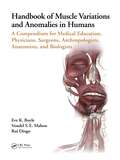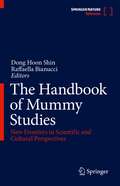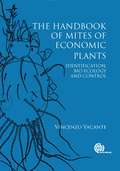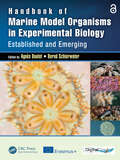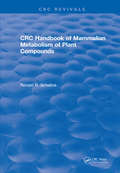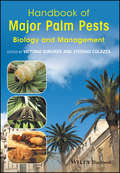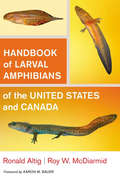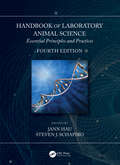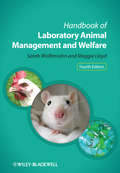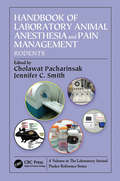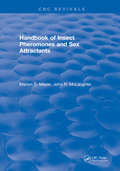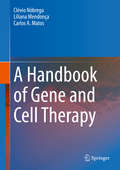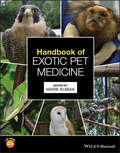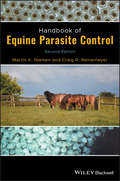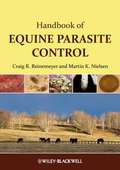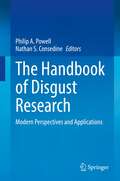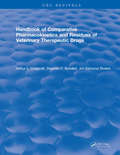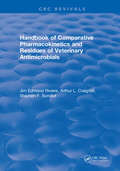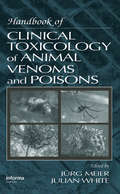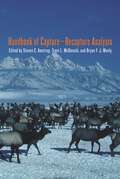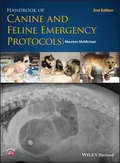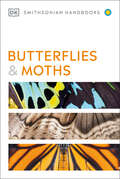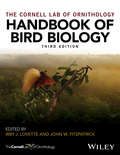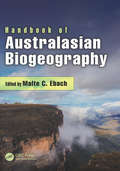- Table View
- List View
Handbook of Muscle Variations and Anomalies in Humans: A Compendium for Medical Education, Physicians, Surgeons, Anthropologists, Anatomists, and Biologists
by Eve K. Boyle Vondel S. Mahon Rui DiogoMost textbooks and atlases of human anatomy chronicle only a few cases of muscle variations in the "normal" human population, or of muscle anomalies within congenital malformations. Consequently, there is a misconception of what is considered "normal" human anatomy and what that looks like. Each person within the "normal" population has at least a few muscle variations, and there are millions of individuals born globally each year with muscle anomalies. There are crucial knowledge gaps between what is taught, what students learn, what textbooks and atlases show, and what truly happens in nature and within our species. This handbook fills this gap by: 1) providing a comparative evolutionary context for muscle variations and defects in humans, 2) summarizing the major types of variations and anomalies found in humans, and 3) including didactic figures for a visually engaging learning experience. This book is of interest to students, professors, and researchers in biological anthropology, comparative anatomy, functional morphology, zoology, and evolutionary and developmental biology, as well as to clinicians and practicing health professionals. Key Features Summarizes most recorded variations and anomalies for each muscle in the human body Provides information on the comparative anatomy of each muscle, including evolutionary differences from our closest living relatives, the apes Includes didactic illustrations of the variations and anomalies for a visually engaging learning experience Comprehensively reviews literature to document prevalence information for each variation and anomaly, within humans Related Titles Brown, D. E. Human Biological Diversity, 2nd ed. (ISBN 978-1-138-03753-3) Diogo, R., et al. Understanding Human Anatomy and Pathology: An Evolutionary and Developmental Guide for Medical Students (ISBN 978-1-4987-5384-5) Diogo, R. Muscles of Chordates: Development, Homologies, and Evolution (ISBN 978-1-138-57116-7)
The Handbook of Mummy Studies: New Frontiers in Scientific and Cultural Perspectives
by Dong Hoon Shin Raffaella BianucciOwing to their unique state of preservation, mummies provide us with significant historical and scientific knowledge of humankind’s past. This handbook, written by prominent international experts in mummy studies, offers readers a comprehensive guide to new understandings of the field’s most recent trends and developments. It provides invaluable information on the health states and pathologies of historic populations and civilizations, as well as their socio-cultural and religious characteristics. Addressing the developments in mummy studies that have taken place over the past two decades – which have been neglected for as long a time – the authors excavate the ground-breaking research that has transformed scientific and cultural knowledge of our ancient predecessors. The handbook investigates the many new biotechnological tools that are routinely applied in mummy studies, ranging from morphological inspection and endoscopy to minimally invasive radiological techniques that are used to assess states of preservation. It also looks at the paleoparasitological and pathological approaches that have been employed to reconstruct the lifestyles and pathologic conditions of ancient populations, and considers the techniques that have been applied to enhance biomedical knowledge, such as craniofacial reconstruction, chemical analysis, stable isotope analysis and ancient DNA analysis. This interdisciplinary handbook will appeal to academics in historical, anthropological, archaeological and biological sciences, and will serve as an indispensable companion to researchers and students interested in worldwide mummy studies.
The Handbook of Mites of Economic Plants
by Vincenzo VacanteMites pose a serious problem to plants worldwide, attacking crops and spreading disease. When mites damage crops of economic importance the impacts can be felt globally. Mites are among the most diverse and successful of invertebrates, with over 45,000 described species, with many more thousands to be discovered. They are responsible for a significant portion of the losses of crops for food, fibre, industry and other purposes, and require expensive and often controversial pest control measures. Understanding these mites is vital for entomologists, pest researchers, agronomists and food producers. Knowledge of mite pests helps to inform control strategies and optimize the production of economic plants and the agrarian economy. This encyclopedia provides a thorough coverage of the mites and the problems they cause to crops, yet it is easily searchable, organised by mite species and subdivided into helpful headings. It takes a worldwide view of the issue of mites injurious to economic plants, describing mites prevalent in different regions and discussing control methods appropriate in different environments. This book provides an encyclopaedic reference to the major mites, described by family in terms of their internal and external morphology, bio-ecology and family systematics. Methods of mite collection and laboratory study is described, as well as species diagnostic characteristics, worldwide distribution, host plants, identification by the type of damage they cause and control strategies, including chemical and biological intervention and integrated pest management measures. Mites of the following families are included: (Eriophyoidea, Tarsonemidae, Tuckerellidae, Tenuipalpidae, Tetranychidae, Acaridae, Penthaleidae). Mites of Economic Plants is an important resource for students of entomology and crop production, and as a thorough reference guide for researchers and field workers involved with mites, crop damage and food production.
Handbook of Marine Model Organisms in Experimental Biology: Established and Emerging
by Agnès Boutet Bernd SchierwaterThe importance of molecular approaches for comparative biology and the rapid development of new molecular tools is unprecedented. The extraordinary molecular progress belies the need for understanding the development and basic biology of whole organisms. Vigorous international efforts to train the next-generation of experimental biologists must combine both levels – next generation molecular approaches and traditional organismal biology. This book provides cutting-edge chapters regarding the growing list of marine model organisms. Access to and practical advice on these model organisms have become a conditio sine qua non for a modern education of advanced undergraduate students, graduate students and postdocs working on marine model systems. Model organisms are not only tools they are also bridges between fields – from behavior, development and physiology to functional genomics. Key Features Offers deep insights into cutting-edge model system science Provides in-depth overviews of all prominent marine model organisms Illustrates challenging experimental approaches to model system research Serves as a reference book also for next-generation functional genomics applications Fills an urgent need for students Related Titles Jarret, R. L. & K. McCluskey, eds. The Biological Resources of Model Organisms (ISBN 978-1-1382-9461-5) Kim, S.-K. Healthcare Using Marine Organisms (ISBN 978-1-1382-9538-4) Mudher, A. & T. Newman, eds. Drosophila: A Toolbox for the Study of Neurodegenerative Disease (ISBN 978-0-4154-1185-1) Green, S. L. The Laboratory Xenopus sp. (ISBN 978-1-4200-9109-0)
Handbook of Mammalian Metabolism of Plant Compounds (CRC Press Revivals)
by Ronald R. SchelineHandbook of Mammalian Metabolism of Plant Compounds provides an extensive survey of how mammals metabolize compounds found in higher plants. Information about these compounds is important to researchers in pharmacology, toxicology, medical and natural products chemistry, and food sciences. Although there is plenty of literature about mammalian metabolism of plant compounds, it is scattered, and summaries of specific plant compounds are often difficult to obtain. This book contains 11 chapters discussing the metabolic fate of individual plant compounds grouped according to chemical class. It also features structural formulas of the compounds and their metabolites, including probable pathways of metabolism. This book provides a convenient single-volume reference source that will benefit all researchers requiring this type of information.
Handbook of Major Palm Pests: Biology and Management
by Stefano Colazza Victoria SorokerHandbook of Major Palm Pests: Biology and Management contains the most comprehensive and up-to-date information on the red palm weevil and the palm borer moth, two newly emergent invasive palm pests which are adversely affecting palm trees around the world. It provides state-of-the-art scientific information on the ecology, biology, and management of palm pests from a global group of experts in the field.An essential compendium for anyone working with or studying palms, it is dedicated to the detection, eradication, and containment of these invasive species, which threaten the health and very existence of global palm crops.
Handbook of Larval Amphibians of the United States and Canada
by Ronald Altig Roy W. Mcdiarmid Aaron M. BauerGenerously illustrated, this essential handbook for herpetologists, ecologists, and naturalists features comprehensive keys to eggs, embryos, salamander larvae, and tadpoles; species accounts; a glossary of terms; and an extensive bibliography. The taxonomic accounts include a summarization of the morphology and basic natural history, as well as an introduction to published information for each species. Tadpole mouthparts exhibit major characteristics used in identifications, and the book includes illustrations for a number of species. Color photographs of larvae of many species are also presented. Handbook of Larval Amphibians of the United States and Canada, written by the foremost experts on larval amphibians, is the first guide of its kind and will transform the fieldwork of scientists and fish and wildlife professionals.
Handbook of Laboratory Animal Science: Essential Principles and Practices
by Jann HauBuilding upon the success of previous editions of the bestselling Handbook of Laboratory Animal Science, first published in 1994, this latest revision combines all three volumes in one definitive guide. It covers the essential principles and practices of Laboratory Animal Science as well as selected animal models in scientific disciplines where much progress has been made in recent years. Each individual chapter focuses on an important subdiscipline of laboratory animal science, and the chapters can be read and used as stand-alone texts, with only limited necessity to consult other chapters for information. With new contributors at the forefront of their fields, the book reflects the scientific and technological advances of the past decade. It also responds to advances in our understanding of animal behavior, emphasizing the importance of implementing the three Rs: replacing live animals with alternative methods, reducing the number of animals used, and refining techniques to minimize animal discomfort. This fourth edition will be useful all over the world as a textbook for laboratory animal science courses for postgraduate and undergraduate students and as a handbook for scientists who work with animals in their research, for university veterinarians, and for other specialists in laboratory animal science.
Handbook of Laboratory Animal Management and Welfare
by Sarah Wolfensohn Maggie LloydThis bestseller has been an essential book for all those working with laboratory animals since it was first published in 1994. This fourth edition retains all the classic features that have made it a must-have reference including emphasis on best practice in order to improve animal welfare. The contents have been thoroughly updated and reorganised to make sure it is a really practical book for day-to-day use in the laboratory. The first section of the book covers principles applicable to all species, for example husbandry, handling and the education and training required by scientists and technical staff working with animals in the laboratory. Later chapters focus on specific species or groups of species.New to this edition:* Reflects changes in European legislation and their impact on national legislation* Covers recommendations for the education and training of those carrying out animal experiments across Europe * New chapters on ethical considerations and balancing animal welfare with science* New information on environmental enrichment for laboratory animals* Covers advancements in anaesthesia and analgesia and techniques* Spiral bound for ease-of-use as a bench-top referenceThis book is ideal for all personnel carrying out scientific procedures using animals, particularly during training and also for the new researcher. It will also be essential reading for study directors designing research programmes, animal technicians and veterinarians working with laboratory animal species.
Handbook of Laboratory Animal Anesthesia and Pain Management: Rodents (Laboratory Animal Pocket Reference)
by Cholawat Pacharinsak Jennifer C. SmithKey features: Presents practical information in easily accessible ‘bullet point’ format Covers anesthetic machine and related equipment, anesthetic management and monitoring, anesthesia and analgesia pharmacology, euthanasia, and record keeping Written by well-recognized experts in the laboratory animal community Provides extensive references to direct the reader to sources for further study of alternative techniques and their procedures Concludes with a thorough chapter on Regulatory Management of Rodent Anesthesia which has global application Rodents are the most commonly used species in biomedical research. Individuals conducting rodent research are often responsible to ensure that all areas of anesthesia and analgesia are performed humanely. Anesthetic agent selection, anesthetic monitoring, and postoperative pain assessment and management are essential to the institutional animal care and use program and contribute significantly to the 3Rs by reducing pain and/or distress and refining various procedures. The Handbook of Laboratory Animal Anesthesia and Pain Management: Rodents is the first book to capture multiple advances in this important area that greatly impacts various experimental methodologies. Richly illustrated in full color, the book serves as a quick reference source for investigators, veterinarians, technicians, and other animal caretakers charged with the care and use of rodents in a research setting. The unique format of this book also makes it extremely valuable to IACUC members, institutional officials, and occupational health and safety professionals.
Handbook of Insect Pheromones and Sex Attractants
by Marion S. MayerThis book focuses on chemicals that effect aggregation for mating and elicit sexual behavior in insects, mites, and ticks, mainly on "sex pheromonal" or "mating" activity. These pheromones are useful to both agriculture science and industry because of their potential as detection and control agents.
A Handbook of Gene and Cell Therapy
by Clévio Nóbrega Liliana Mendonça Carlos A. MatosThis is a reference handbook for young researchers exploring gene and cell therapy. Gene therapy could be defined as a set of strategies modifying gene expression or correcting mutant/defective genes through the administration of DNA (or RNA) to cells, in order to treat disease. Important advances like the discovery of RNA interference, the completion of the Human Genome project or the development of induced pluripotent stem cells (iPSc) and the basics of gene therapy are covered. This is a great book for students, teachers, biomedical researchers delving into gene/cell therapy or researchers borrowing skills from this scientific field.
Handbook of Exotic Pet Medicine
by Marie KubiakEasy-to-use, comprehensive reference covering the less common species encountered in general veterinary practice Handbook of Exotic Pet Medicine provides easy-to-access, detailed information on a wide variety of exotic species that can be encountered in general veterinary practice. Offering excellent coverage of topics such as basic techniques, preventative health measures, and a formulary for each species, each chapter uses the same easy-to-follow format so that users can find information quickly while working in the clinic. Presented in full colour, with over 400 photographs, the book gives small animal practitioners the confidence to handle and treat more familiar pets such as budgerigars, African grey parrots, bearded dragons, corn snakes, tortoises, pygmy hedgehogs, hamsters and rats. Other species that may be presented less frequently including skunks, marmosets, sugar gliders, koi carp, chameleons and terrapins are also covered in detail to enable clinicians to quickly access relevant information. Provides comprehensive coverage of many exotic pet species that veterinarians may encounter in general practice situations Presents evidence-based discussions of topics including biological parameters, husbandry, clinical evaluation, hospitalization requirements, common medical and surgical conditions, radiographic imaging, and more The Handbook of Exotic Pet Medicine is an ideal one-stop reference for the busy general practitioner seeing the occasional exotic animal, veterinary surgeons with an established exotic animal caseload, veterinary students and veterinary nurses wishing to further their knowledge.
Handbook of Equine Parasite Control
by Martin K. Nielsen Craig R. ReinemeyerHandbook of Equine Parasite Control, Second Edition offers a thorough revision to this practical manual of parasitology in the horse. Incorporating new information and diagnostic knowledge throughout, it adds five new sections, new information on computer simulation methods, and new maps to show the spread of anthelmintic resistance. The book also features 30 new high-quality figures and expanded information on parasite occurrence and epidemiology, new diagnostics, treatment strategies, clinical significance of infections, anthelmintic resistance, and environmental persistence. This second edition of Handbook of Equine Parasite Control brings together all the details needed to appropriately manage parasites in equine patients and support discussions between horse owners and their veterinarians. It offers comprehensive coverage of internal parasites and factors affecting their transmission; principles of equine parasite control; and diagnosis and assessment of parasitologic information. Additionally, the book provides numerous new case histories, covering egg count results from yearlings, peritonitis and parasites, confinement and deworming, quarantine advice, abdominal distress in a foal, and more. A clear and concise user-friendly guide to equine parasite control for veterinary practitioners and students Fully updated with new knowledge and diagnostic methods throughout Features brand new case studies Presents 30 new high-quality figures, including new life-cycle charts Provides maps to show the spread of anthelmintic resistance Handbook of Equine Parasite Control is an essential guide for equine practitioners, veterinary students, and veterinary technicians dealing with parasites in the horse.
Handbook of Equine Parasite Control
by Craig Reinemeyer Martin NielsenA must-have guide for any equine veterinarian, this is a practical and concise handbook on the control of equine parasites. It enables you to advise your clients effectively on evidence-based parasite control programs. The first section of the book reviews the basic biology of internal parasites and the factors influencing their transmission. The second section discusses the general principles of parasite control. The third section provides diagnostic and assessment tools for interpreting clinical, historical and laboratory information. Finally the fourth section contains 20 case studies reflecting the full range of parasites and providing detailed answers and discussions, providing you with the opportunity to practice the application of knowledge and illustrating the concepts of modern parasite control.Handbook of Equine Parasite Control is an invaluable companion for equine veterinary practitioners, veterinary students, equine veterinary technicians and nurses, researchers in equine parasitology, horse owners, and farm and stable managers.
The Handbook of Disgust Research: Modern Perspectives and Applications
by Philip A. Powell Nathan S. ConsedineThis volume brings together the world's leading experts on disgust to fully explore this understudied behavior. Disgust is unique among emotions. It is, at once, perhaps the most “basic” and visceral of feelings while also being profoundly shaped by learning and culture. Evident from the earliest months of life, disgust influences individual behavior and shapes societies across political, social, economic, legal, ecological, and health contexts. As an emotion that evolved to prevent our eating contaminated foods, disgust is now known to motivate wider behaviors, social processes, and customs. On a global scale, disgust finds a place in population health initiatives, from hand hygiene to tobacco warning labels, and may underlie aversions to globalization and other progressive agendas, such as those regarding sustainable consumption and gay marriage.This comprehensive work provides cutting‐edge, timely, and succinct theoretical and empirical contributions illustrating the breadth, rigor, relevance, and increasing maturity of disgust research to modern life. It is relevant to a wide range of psychological research and is particularly important to behavior viewed through an evolutionary lens, As such, it will stimulate further research and clinical applications that allow for a broader conceptualization of human behavior.The reader will find:Succinct and accessible summaries of key perspectivesHighlights of new scientific developmentsA rich blend of theoretical and empirical chapters
Handbook of Comparative Pharmacokinetics and Residues of Veterinary Therapeutic Drugs
by Arthur L. CraigmillHandbook of Comparative Pharmacokinetics and Residues of Veterinary Therapeutic Drugs is a unique compilation of comparative pharmacokinetic data for veterinary therapeutic drugs. The book features an excellent introductory chapter on basic veterinary pharmacokinetics and includes pharmacological data taken from hundreds of primary research references. These data are presented in standardized units and are arranged in conveniently organized tables so that comparisons between data can be made easily. Much of the data is new and was taken from articles in which data was not subjected to pharmacokinetic analysis.
Handbook of Comparative Pharmacokinetics and Residues of Veterinary Antimicrobials
by Jim E RiviereThe major objective of this handbook is to compile-in tabular form-the pharmacokinetic parameters of antimicrobial drugs used in food animals. This unique publication represents data from the FARAD (Food Animal Residue Avoidance Databank) databank, established by the authors under the auspices of the U.S.D.A. and contains significant amounts of previously unavailable information. This updated, one-of-a-kind volume even features additional data on laboratory rodents, dogs, cats, and horses in order to facilitate broader interspecies extrapolations. This easy-to-use reference is timely as well as invaluable to animal scientists, veterinarians, pharmacologists, and toxicologists who work with antimicrobials in chickens, turkeys, dairy and beef cattle, swine, goats, and sheep.
Handbook of Clinical Toxicology of Animal Venoms and Poisons
by Julian White Jurg MeierThe Handbook of Clinical Toxicology of Animal Venoms is the first concise, one-volume book devoted to this important subject. The editors are internationally recognized authorities in the biology and clinical aspects of venomous and poisonous animals, and the chapter authors are world leaders in their respective fields of toxicology.All aspects of the topic are covered including information on the biology and taxonomy of poisonous animals, their venom or poison, diagnosis, and general treatment principles and specific treatment. The most up-to-date list of available antivenoms is provided. Coverage of venomous and poisonous animals is comprehensive, with thorough discussions on shellfish poisoning, ciguatera, fugu, coelenterates, stingrays, venous fish, blue-ringed octopus, sea-snakes, scorpions, spiders, insects, and gila lizards. Individual chapters focus on snakes and snakebite in Europe, Africa, Asia, Australia, North America, Central America, and South America. Nearly all clinical chapters have been written by clinicians with extensive experience treating the particular type of animal envenoming or poisoning under consideration.No other book brings together such a wealth of information in this field, and no other book provides it in a format useful to clinicians charged with the responsibility of treating envenomed or poisoned patients. The Handbook of Clinical Toxicology of Animal Venoms is an essential addition to all medical libraries, emergency departments, toxicology departments, poison information centers, and invaluable to all professionals working in these fields.
Handbook of Capture-Recapture Analysis
by Steven C. Amstrup Trent L. McDonald Bryan F. J. ManlyEvery day, biologists in parkas, raincoats, and rubber boots go into the field to capture and mark a variety of animal species. Back in the office, statisticians create analytical models for the field biologists' data. But many times, representatives of the two professions do not fully understand one another's roles. This book bridges this gap by helping biologists understand state-of-the-art statistical methods for analyzing capture-recapture data. In so doing, statisticians will also become more familiar with the design of field studies and with the real-life issues facing biologists. Reliable outcomes of capture-recapture studies are vital to answering key ecological questions. Is the population increasing or decreasing? Do more or fewer animals have a particular characteristic? In answering these questions, biologists cannot hope to capture and mark entire populations. And frequently, the populations change unpredictably during a study. Thus, increasingly sophisticated models have been employed to convert data into answers to ecological questions. This book, by experts in capture-recapture analysis, introduces the most up-to-date methods for data analysis while explaining the theory behind those methods. Thorough, concise, and portable, it will be immensely useful to biologists, biometricians, and statisticians, students in both fields, and anyone else engaged in the capture-recapture process.
Handbook of Canine and Feline Emergency Protocols
by Maureen McmichaelHandbook of Canine and Feline Emergency Protocols, Second Edition offers practical step-by-step guidance to managing emergency cases in small animal practice. Presenting more than 165 complete protocols for triaging, stabilizing, and managing emergent patients, the book is designed for fast access in an emergency situation, with a spiral binding and tabs to make it easy to flip to the relevant section. An ideal resource for veterinary practitioners seeking a quick reference for dog and cat emergencies, this Second Edition provides enhanced imaging information to increase the book's diagnostic usefulness and full updates throughout. Logically organized alphabetically by category of emergency, the book includes useful chapters on procedures, shock, toxicology, and trauma in addition to a procedures chapter. Video clips, additional images, review questions, formula calculations, and quick reference guides are available on a companion website. Handbook of Canine and Feline Emergency Protocols, Second Edition provides a user-friendly daily reference for any small animal practitioner.
Handbook of Butterflies and Moths (DK Handbooks)
by David CarterA compact, comprehensive field guide to over 500 butterfly and moth species from around the world.The clearest and sharpest recognition guide to over 500 butterfly and moth species from around the world. Authoritative text, crystal-clear photography, and a systematic approach make this the most comprehensive and concise pocket guide to the butterflies and moths of the world. Packed with more than 600 full-colour photographs of over 500 species, this handy reference book is designed to cut through the process of identification and help you to recognize a species quickly and easily. Expertly written and thoroughly vetted, each entry combines a precise description with annotated photographs to highlight the characteristics and distinguishing features of each butterfly or moth, while also providing at-a-glance facts for quick reference. The introduction explains the difference between butterflies and moths, details the life cycle from egg to adult, rearing your own specimens, and offers guidance for finding and observing live specimens in the wild. A concise glossary defines technical and scientific terms. Compact enough to take out into the field, DK Handbooks: Butterflies & Moths makes identifying these beautiful insects easier than ever before.
The Handbook of Bird Photography
by Bence Mate Jari Peltomaki Markus VaresvuoThe Handbook of Bird Photography distills the knowledge, talent, and experience of three well-known professional wildlife photographers into one beautifully illustrated volume. Written in a manner that is easy to understand, this book offers fresh insight and practical tips that will broaden horizons for nature and bird photographers. The authors share their stories showcasing photographs for which they have received awards in major international wildlife photo competitions. In this book, you'll learn about all of the elements that lead to a great bird photograph, including:The bird photographer's equipment Shooting techniques: exposure, focus, how to show movement and freeze action, etc. In the field: bird behavior, hides, and how to attract birds How to use light and compose and crop images The best sites for finding and photographing birds You'll also learn how to show, share, promote, and sell your photographs. Bird photography is a brilliant way to spend your free time, and for some it's a career. This book helps beginners get the hang of things quickly and accurately, and offers field-specific expertise for more experienced photographers.
Handbook of Bird Biology
by John W. Fitzpatrick Irby J. Lovette"This wonderful handbook provides a crystal-clear introduction to every fascinating aspect of bird biology. It will now be my own first reference source about birds, and it should be yours, too - regardless of whether you are a backyard bird watcher, a hard-core birder, or a professional ornithologist." Jared Diamond, Professor of Geography at the University of California-Los Angeles, specialist on New Guinea birds, and Pulitzer-Prize winning author."This new edition of the Cornell Lab of Ornithology's Handbook of Bird Biology is a stunning resource for professionals and amateurs alike. It is graced by color photos spilling off nearly every page and filled with clear yet detailed interpretations of the latest ornithological discoveries. One can't achieve a better mix of technical accuracy and a pleasing, accessible format. It's all here - bird evolution, ecology, physiology, conservation, and much more." Scott V. Edwards, Alexander Agassiz Professor of Zoology and Curator of Ornithology at Harvard UniversityBirds thrive in all conditions, from urban neighborhoods to the remotest oceans, driest deserts, and the wettest rainforests. From the tiniest hummingbird to the largest ostrich, their varied forms fascinate us - from drab to ostentatious, silent to raucous, earthbound to global nomad. This much-anticipated third edition of the Handbook of Bird Biology is an essential and comprehensive resource for everyone interested in learning more about birds, from casual bird watchers to formal students of ornithology. Wherever you study birds your enjoyment will be enhanced by a better understanding of the incredible diversity of avian lifestyles. Arising from the renowned Cornell Lab of Ornithology and authored by a team of experts from around the world, the Handbook covers all aspects of avian diversity, behaviour, ecology, evolution, physiology, and conservation. Using examples drawn from birds found in every corner of the globe, it explores and distills the many scientific discoveries that have made birds one of our best known - and best loved - parts of the natural world. This edition has been completely revised and is presented with more than 800 full color images. It provides readers with a tool for life-long learning about birds and is suitable for bird watchers and ornithology students, as well as for ecologists, conservationists, and resource managers who work with birds.
Handbook of Australasian Biogeography (CRC Biogeography Series)
by Malte C. EbachThe Handbook of Australasian Biogeography is the most comprehensive overview of the biogeography of Australasian plants, fungi and animal taxa in a single volume. This volume is unique in its coverage of marine, freshwater, terrestrial, and subterranean taxa. It is an essential publication for anyone studying or researching Australasian biogeography. The book contains biogeographic reviews of all major plant, animal and fungal groups in Australasia by experts in the field, including a strong emphasis on invertebrates, algae, fungi and subterranean taxa. It discusses how Australasia is different from the rest of the world and what other areas share its history and biota.
